Climate Models to Study Sea Level Rise
https://usasciencefestival.org/wp-content/uploads/2023/08/Climate-Models-to-Study-Sea-Level-Rise.docx.pdf
https://usasciencefestival.org/wp-content/uploads/2023/08/Climate-Models-to-Study-Sea-Level-Rise.docx.pdf
Jess Noffsinger, X STEM All Access
In this resource, students will analyze data to determine the extent and impact of ice sheet melt and sea level rise using a variety of NASA Resources.
This learning activity takes six 50 minute class periods.
Learn more about Teaching Climate Literacy and Energy Awareness»Grade Level
Online Readiness
Topics
Climate Literacy
This Activity builds on the following concepts of Climate Literacy.
Click a topic below for supporting information, teaching ideas, and sample activities.
Notes From Our Reviewers
The CLEAN collection is hand-picked and rigorously reviewed for scientific accuracy and classroom effectiveness.
Read what our review team had to say about this resource below or learn more about
how CLEAN reviews teaching materials
Teaching Tips | Science | Pedagogy |
Technical Details
Teaching Tips
- This multi-day (week long) set of activities builds student understanding through exploring visuals and data of the connections between ice melt on Greenland, sea level rise and the impacts of sea level rise on several global coastlines.
- The activities would fit well within a unit on climate, glaciers or systems thinking.
- This is a quality, self-contained lesson plan.
About the Content
- The activity builds an understanding of sea level rise by considering ice melt in Greenland. The lesson begins with a warm-up activity based on a visual to generate ideas and questions. Students explore content through a jigsaw activity and then share in a gallery walk. NASA resources are heavily relied upon for this section of the activity.
- The activity is designed to encourage critical thinking about sea level rise using a National Geographic article and reading guide. Here the connections between ice melt, human activity and sea level rise are built.
- Thermal expansion of seawater is mot mentioned, educators may want to address this topic.
- Links are provided to data. Links are provided to classroom-ready Google Docs.
- There is a companion 30 minute X-STEM video that focuses on careers in climate science and one scientist's work on Greenland ice melt.
- Numerous outside resources from reputable scientific sites have been incorporated into the lesson plan.
- Passed initial science review - expert science review pending.
About the Pedagogy
- The activity is designed as an activity that is best suited for high school students and that will require 5-6 days of class time plus assessment time.
- Each component of the activity builds on the previous one as students develop an understanding of the scope of ice melt in Greenland, its impact on sea level rise and the resulting impact on global coastlines.
- There is an accompanying 30 minute video that focuses on careers in climate science and the experiences of a Greenland climate scientist studying ice melt.
- A basic lesson plan is offered as a teacher's guide. No additional materials are provided. The resource includes scaffolding, and the use of jigsaw and gallery walk activities engage students in discovering information and sharing it with classmates.
- Students should have a basic understanding of the water cycle, systems science vocabulary and maps.
- The list of required materials at the end of the lesson plan is an underestimate of the materials needed if doing an in-person gallery walk activity.
- This resource engages students in using scientific data.
See other data-rich activities
Technical Details/Ease of Use
- Computers are required for students to collect data and view visuals.
- Two links did not lead to the intended resources at the time of review. The first link given in the Opening Activity is meant to be for a video on from NASA Climate, but it no longer goes to a video. The link to Amazon Delta under Differentiation Tip within Elaborate: Applications and Extensions does not go to relevant information. Otherwise, the resource includes many links to very informative and engaging sites.








